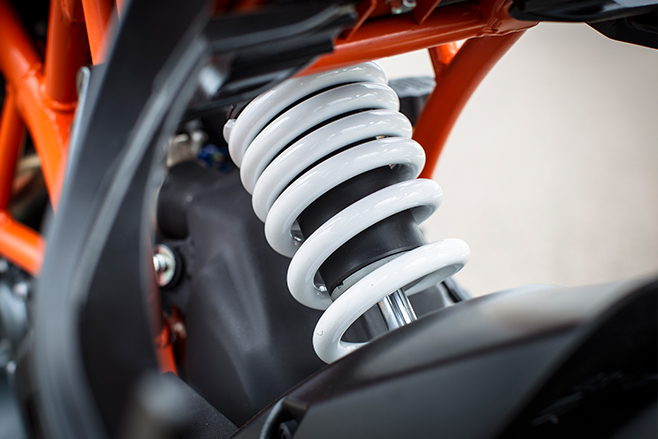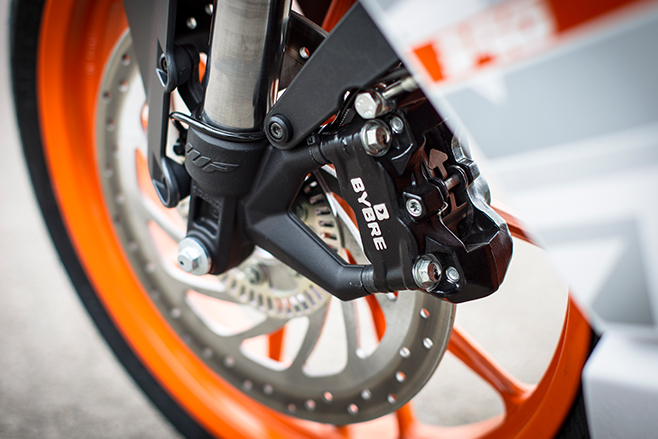The KTM RC390 is on a spa and pamper holiday in New South Wales at the moment, in the experienced and caring hands of suspension guru Terry Hay at Shock Treatment.
Our hope and aim in sending our favourite little repli-racer off for an attitude adjustment is to transform it into a real-racer, with the track manners to match its Moto3 looks.
There’s no doubt the RC390’s chassis has a lot going for it when compared to the other ultra-lightweight supersport bikes on the market. For starters, at just under 150kg dry it is genuinely lightweight, as opposed to just being physically small. The stout 43mm WP USD front fork, despite being quite basic internally, are ahead of the low-tech and spindly conventional forks of the competition. Similarly, the four-piston ByBre front brake caliper is the best stopper in the category.

All this adds up to true track potential, particularly once the concessions to road use are addressed. The main issue here is the stock suspension, which is tuned for road comfort, not racetrack rigidity.
Both front and rear standard springs have a progressive rate, which is fine for low-speed compliance, but doesn’t offer the support for serious scratching. A set of firmer linear springs will be the most important step to taking the KTM from wannabe to can do track weapon, and the stiffer springs will need a corresponding adjustment in the damping characteristics of the forks and shock.

Terry Hay has discovered the RC390 fork has a very similar internal damping system to KTM’s SX65 mini-motocross bike. This is great news for our long-termer ambitions, as Terry’s experience with tuning suspension for some of the fastest dirt squirts in the country will come in handy for revalving the RC390. With no external suspension adjustment on the KTM other than rear preload, getting the valving right will be critical to the project being a success, as any further adjustments will require complete disassembly of the rear shock, or at best a change of oil viscosity in the forks.
Once we have the KTM back at Horror HQ, an overhaul of the brakes will be first on the agenda, with fresh fluid, new race spec brake pads, and possibly even a new disc more suited to track use. The swept area of the standard front disc – the part of the disc which contacts the brake pads – is far narrower than the useable surface area. The problem with this is it can sometimes cause the disc to dish (warp into a dish shape) under extreme use, because the outer edge is heating and cooling at a different rate to the inner edge. It’s far better to have a thicker disc which matches the swept area of the pad perfectly.
Sponged
The RC390’s track day at Phillip Island a few months back ended with a severely spongy brake lever at the end of the day. Although not a track where there is constant heavy braking, the combination of heavy braking followed by high speeds creates extreme heat fluctuations. The disc can get quite cold due to the high wind flow around it between each arrival at Honda hairpin, where temperatures instantly skyrocket. This can play havoc with thin solidly mounted discs like the KTM’s.

The KTM RC390 race series bikes are fitted with a race quality floating disc to make them track ready, and we’ll be seeking a similar solution. The ByBre caliper is more than up to the job, but some race pads should complete the package nicely.
Boing!
Increasingly wider gaps between the coils identify this as a progressive spring, with a softer spring rate at the start of travel, then progressively firmer. Comfy, but not so good for track use.
Thanks to
Terry Hay | Shock Treatment (He can do loads of other stuff, too!)
Contact
Ph: (02) 4773 9115 shocktreatment.com.au
Stay tuned for further installments of how the RC390 stacks up trackside.
This article appears in AMCN Vol 64 No 25